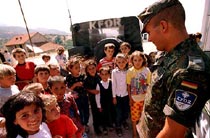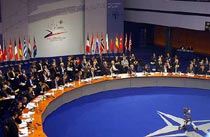| (insert your NIE or newspaper logo here) |
Weekly Online LessonOnline Lesson ArchiveGrade Level: 7-12
|
NATO in the 21st Century
 For
the last few years, a civil war has raged in the Darfur
region of Sudan, killing thousands of people and displacing
well over a million.
For
the last few years, a civil war has raged in the Darfur
region of Sudan, killing thousands of people and displacing
well over a million.
In 2004, the United Nations called it, "The world's worst humanitarian crisis."
Since then, peacekeepers, primarily from the African Union, have been caring for refugees in bordering countries, like Chad.
But relief efforts have been slow and general security, even in areas across the border, has been failing.
Last month, the UN Security Council proposed a plan to double the number of peacekeepers in the region by the end of the year. On Friday, February 17, 2006, President George W. Bush said he supported that proposal, which includes expanding NATO's role in the efforts.
While most people are familiar with the UN, NATO may be a bit of a mystery—we've heard the name but aren't really sure who they are or what they do and why.
Similar to the UN, the NATO alliance was formed to ensure peace and security worldwide. NATO, which stands for "North Atlantic Treaty Organisation," is different from the UN, however, in that it works by specifically integrating European and North American diplomatic and military forces.
For this week's lesson, you'll learn about the history of NATO, along with its current role in the global community.
NATO's Mission
 Begin your lesson at the NATO website,
and explore NATO's E-generation section.
On the E-publications page,
and click Welcome to NATO.
Begin your lesson at the NATO website,
and explore NATO's E-generation section.
On the E-publications page,
and click Welcome to NATO.
Explore the topics titled, What is NATO?, What does NATO do?, How does NATO work?, and NATO's Agenda. Read through each section and explore the related topics and key links.
What are NATO's mission and goals? How many countries are currently members? What is NATO's strategy, and how does it define "security"? Where and in what ways have member nations worked together and why? In what ways has the alliance changed since the turn of the 21st century and what factors have influenced those changes?
What have been NATO's contributions to crisis management efforts in Darfur, Afghanistan, and Iraq? Why did NATO undertake those missions? What other alliances are involved?
 How
does NATO make decisions about their involvement in
relief efforts and other operations? Who are some of NATO's partner organizations?
What changes were adopted by NATO during the 2002 and 2004 summits? What
other changes are on NATO's agenda to face the threats and conditions
in the 21st Century?
How
does NATO make decisions about their involvement in
relief efforts and other operations? Who are some of NATO's partner organizations?
What changes were adopted by NATO during the 2002 and 2004 summits? What
other changes are on NATO's agenda to face the threats and conditions
in the 21st Century?
To see more specific examples of what NATO does, go back to the E-publications page and click for the NATO Xperience.
As you explore the module, check out all of the photos, audio clips and videos to learn more about the benefits of NATO, how they work with other organizations, and what contributions NATO has made to other relief efforts, like those in the Balkans region.
Next, delve into the deeper history of NATO at the website's NATO Update section. Start at the beginning at 1945 and browse through the years to the present.
Which countries wanted to create this alliance and why? What was the Warsaw Pact and how did it relate to NATO? In what ways did the alliance help nations work with each other to resolve conflicts? How did issues, such as poverty or oppressive leadership, influence NATO decision-making and actions? How has NATO changed over time?
NATO Membership
 Many
nations have used their NATO membership to obtain assistance and support
in challenging times. After the attacks of September 11, 2001, for example,
the United States invoked Article
5 of the treaty, its mutual defense clause, meaning that an attack
on one was an attack on all.
Many
nations have used their NATO membership to obtain assistance and support
in challenging times. After the attacks of September 11, 2001, for example,
the United States invoked Article
5 of the treaty, its mutual defense clause, meaning that an attack
on one was an attack on all.
This is just one of the treaty's many powerful clauses that makes the alliance a desirable one to join. And, certainly, the more stable and loyal members NATO can pull in, then the stronger the alliance can be to carry out its mission.
As you likely noticed, NATO has grown from its original 12 members. In 2004, seven countries were accepted to Enlarge the Alliance. What is the "open door" policy?
Review the Membership Action Plan,and read about the four steps potential members must take at The Road to NATO Membership section. Why do you think this process is important?
If you have time, check out the Maps that highlight NATO member and partner countries. Also, browse through the Virtual Exhibits, which explain more about the North Atlantic Council, and other key topics and issues.
Newspaper Activities
Over the next month or so, read through Targetnewspaper to find news stories that mention NATO or any other peace-keeping alliances. Identify and summarize the who, what, where, and why of each news item. Post the summary with a map that highlights the nations involved in relief or peacekeeping efforts that the news article notes. (You may wish to use additional research for a more complete picture.) For example, if you find news about the problems in Darfur, use a highlighter to color that region or all of Sudan, and use other colors to illustrate which nations are contributing assistance through their alliance organizations. Use one color to identify NATO members, another for UN members, etc. If a nation is involved through more than one alliance, then you may want to color that nation with the appropriate color combination in a striped pattern. Discuss the distributions and contributions of these groups, as wells as the reasons those groups, and individual countries, would want to support peace and stability in that troubled area.
© Copyright 2006
Learners Online, Inc.
